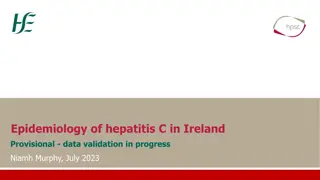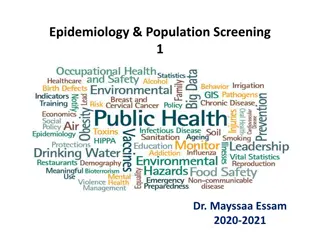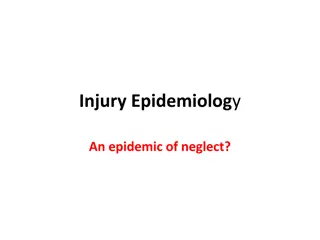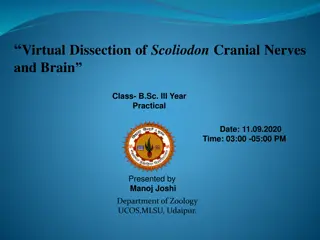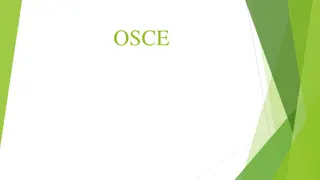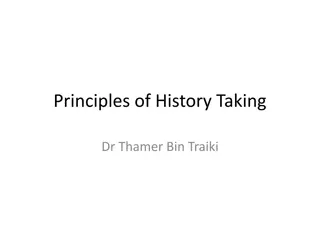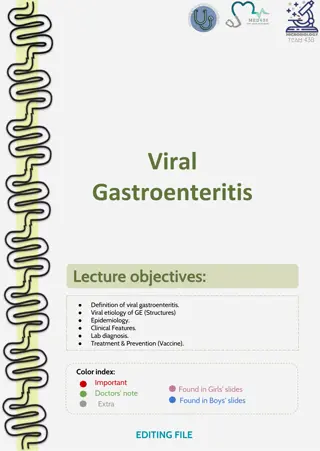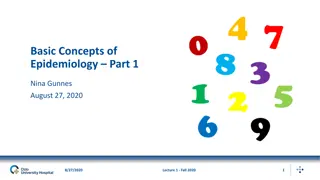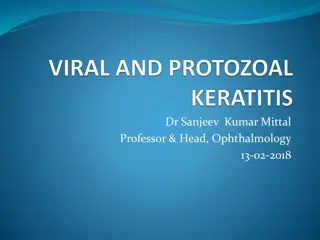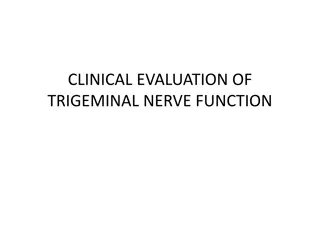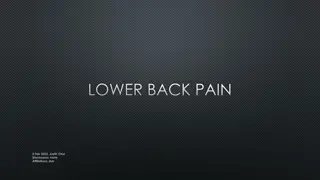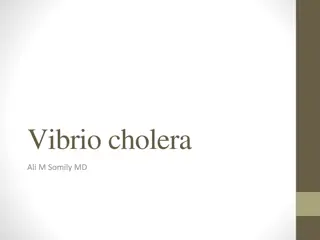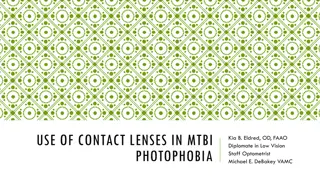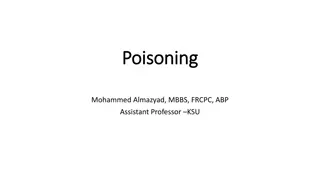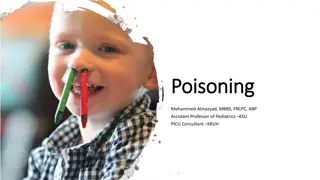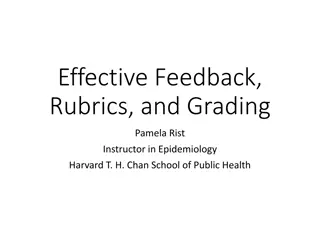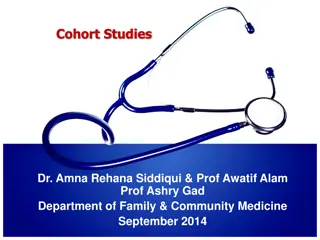Trigeminal Neuralgia: History, Epidemiology, Clinical Features
Trigeminal Neuralgia (TN) has a rich historical background, with early descriptions dating back to the 2nd century. This condition is characterized by severe, unilateral facial pain along the divisions of the trigeminal nerve. The epidemiology shows a female predominance, typically affecting individuals around 50 years old. Clinical features include paroxysmal lancinating pain triggered by various activities. Pain relief is often achieved with medications like carbamazepine. Distribution of TN varies across the trigeminal nerve branches. Understanding the pathophysiology, differential diagnoses, and management strategies is crucial for tackling this debilitating condition.
Download Presentation

Please find below an Image/Link to download the presentation.
The content on the website is provided AS IS for your information and personal use only. It may not be sold, licensed, or shared on other websites without obtaining consent from the author.If you encounter any issues during the download, it is possible that the publisher has removed the file from their server.
You are allowed to download the files provided on this website for personal or commercial use, subject to the condition that they are used lawfully. All files are the property of their respective owners.
The content on the website is provided AS IS for your information and personal use only. It may not be sold, licensed, or shared on other websites without obtaining consent from the author.
E N D
Presentation Transcript
History Aretaeus of Cappodocia provided one of the earliest descriptions in 2ndcentury- first account of TN. 1756, the French surgeon Nicholas Andre coined the term tic douloureux . 1773- Fothergill described typical features of TN. 1820 s- Charles Bell attributed this to disease of V nerve.
Epidemiology Incidence:4-5/100,000 Also known as Fothergill s disease/Tic Douloureux/Suicide Disease Female predominance (M: F = 1:2 -2:3) Mean age: 50 yrs
Clinical features A diagnosis of TN is always based on the patient s clinical history. Hallmark pain is agonising, paroxysmal and lancinating along one/ more divisions of V nerve. Pain is virtually always unilateral, most commonly in V2 distribution. Triggered by activities such as chewing, speaking, swallowing, touching the face, or brushing the teeth. Periods of remissions and exacerbations
Pain typically more severe in morning and disappears during sleep Pain relief when treated with carbamazepine. Pain free intervals are common- weeks to as long as years Recurrences are common- at the site of initial complaint Neurological examination is essentially normal except a slight degree of sensory loss (usually ipsilateral nasolabial fold commonly) Burning, aching pain with no trigger points- Atypical TN
Distribution of trigeminal neuralgia V1 4% V2 35% V3 30% V1 AND V2 10% V2 AND V3 20%
Pathophysiology Nerve injury Central and peripheral demyelination Ectopic action potentials in the sensory nerve root Paroxysmal, lancinating attacks
D/D Glossopharyngeal neuralgia Post herpetic neuralgia Geniculate neuralgia (Hunt neuralgia) TM joint pain Cluster headache Dental, orbital pain or sinusitis Etiology: Idiopathic (Vascular loops) Tumours AVM, aneurysm Inflammatory- Multiple sclerosis, sarcoidosis, Lyme disease
MANAGEMENT- Investigations
MR Imaging Most important imaging: Used to identify Stuctural lesions ( Cavernomas, V nerve schwannomas, meningiomas) Vascular loops White matter lesions in brain stem/ subcortical white matter(f/o MS) If MS is suspected- then LP for oligoclonal bands and evoked potentials to be done. Good quality, thin (1 mm thick) section with contrast to be done. 3 D CISS (Constructive interference in steady state) MR angio has 95% sensitivity and 100% specificity for identifying vascular compression .
Treatment Medical Surgical
Classes of drugs used in TN AED s Carbazepine/ Baclofen/ Phenytoin Antidepressants Amitryptiline/ Nortryptiline Neuroleptics Fluphenazine Opioids
Medical line First line Carbamazepine Phenytoin Valproate Baclofen Amitryptiline Nortryptiline Second line Gabapentin Oxcarbazepine Lamotrigine Topiramate Zonisamide Levetiracetam
AED s in TN Historically, potassium bromide used Later, phenytoin use described in 1942. Carbamazepine (1961)- Mainstay of medical therapy Baclofen- only other effective first line drug. MOA- Enhance inhibitory neuronal activity in the trigeminal nucleus. No double blind RCT for drugs used in trigeminal neuralgia.
Carbamazepine (Tegretal/Mazetol) Use in TN first described in 1962. Shown to be effective in the treatment of TN in a number of studies Sodium-channel modulator Initial response is virtually universal (If no response-then reconsider diagnosis) Initial response rate- 80%; By 10 yrs it drops to 50% Dosing: Start at 200 mg/d. Add up to 200 mg in intervals of 4-5 days until pain relief. Typical dose 1200 mg/day Dose may need to be increased after several weeks because of auto-induction (as t reduces)
Adverse effects- seen in 20-40% pts Neurologic- Ataxia, Dizzniess, Diplopia, vertigo Systemic- GI irritation, hyponatremia, hypersensitivity, Asymptomatic elevation of liver enzymes , rarely severe hepatotoxicity Rare- Aplastic anemia, agranulocytosis, thrombocytopenia, and Stevens-Johnson syndrome. Drug interactions: Level decreased by enzyme-inducing drugs Level increased by erythromycin, propoxyphene, isoniazid, cimetidine, fluoxetine Monitoring: CBC, LFT,RFT 2 weekly for 2 months Later, 3 monthly
Baclofen Analogue of GABA Promotes segmental inhibition at the nucleus oralis of trigeminal brainstem complex. t 3-4 hrs; renal elimination Synergism with CBZ/phenytoin 30% develop resistance in long term Dose: Start with 10 mg TDS, increase gradually; Typical maintainence dose: 50-60 mg/day Side effects: Somnolence/ dizziness/ GI distress Usually well tolerated- no life threatening A/E No known drug interactions Withdraw gradually (or else Seizures and hallucinations can occur)
Phenytoin Sodium channel blocker Also tried in TN but not that effective (25-60%) Dose 5-7 mg/kg/day Pain relief within 2 days of therapy
First generation drugs Advantages: Physician s familiarity with the drug Low cost Reasonable degree of efficacy These medications are present in most formularies Disadvantages: Complicated pharmacokinetics (often nonlinear) Higher levels of protein binding Narrow therapeutic indices Drug drug interactions.
Second generation AED s Gabapentin GABA analogue Halts the formation of new synapses Effective in cases resistant to traditional treatment modalities Effective daily dose: upto 3 gm/day Adverse effects: Dizziness, weight gain, peripheral edema, mood swings Pregabalin: Successor of Gabapentin More potent, absorbs faster and greater bioavailability 70% response rate within 6-8 weeks Dose: 150-600 mg/day Obermann et al: Cephalgia 2008
Oxcarbazepine (Trileptal)- Prodrug As effective as CBZ Less toxic, no hepatic enzyme induction, improved side effect profile Lamotrigine: Acts presynaptically on voltage-gated sodium channels to decrease glutamate release. Effective in refractory TN (as an add on drug to the combination) Usually well tolerated Most serious A/E- Stevens- Johnson syndrome
Drug Dosage Common side effect Severe adverse reaction Carbamazepine Start with 100-300 mg/day Therapeutic range: 800-1200 mg/day Dizziness/ somnolence/ nausea/ vomiting/ rash Aplastic anaemia, Stevens- Johnson syndrome Phenytoin Start with 200-300 mg/day Therapeutic range: 5-7 mg/kg/day Nystagmus/ Ataxia/ diplopia/ rash/ gingival hyperplasia/ Hepatitis/ Stevens- Johnson syndrome Baclofen Start with 30 mg/day Therapeutic range: 50-60 mg/day Lethargy/ Ataxia/ GI distress Seizures/ hallucinations Oxcarbazepine Start with 300 mg/day Therapeutic range: 800-1200 mg/day Dizziness/ somnolence/ nausea/ vomiting Unknown
Other drugs Sodium valproate Proparacaine eye drops Tocainide (LA) Caspaicin New drugs: Dextromethorphan NSAID- Misoprostol Botulinum toxin
Assessment score BNI score 1-no pain, no medications 2-occasional pain, no medications 3-some pain, adequately controlled with medications 4-some pain, not adequately controlled with medication 5-severe pain/ no relief
SURGICAL MANAGEMENT Gasserian ganglion-level procedures Microvascular decompression (MVD) Ablative treatments Radiofrequency thermocoagulation (RFT) Glycerol rhizolysis (GR) Balloon compression (BC) Stereotactic radiosurgery (SRS) Peripheral procedures Peripheral neurectomy Cryotherapy (cryonanlgesia) Alcohol block
Microvascular decompression (Jannetta procedure) Dandy in 1934- Anatomic observations made during post. fossa exploration Gardner and Sava- 1959 first developed MVD Janetta-1977 perfected and popularized the technique Indications: Relatively young pts with definite vascular loop and no other major co-morbidities Contraindications: Only absolute C/I- Patients unfit for GA Relative C/I- Multiple sclerosis Elderly pts- not a C/I: equally good outcome as compared to young pts Gunther et al: Neurosurgery Sep 2009
Offending vessels: Arterial: 85%: Venous-68%, sole venous- only- 12%; Both- 55% Arterial SCA- 75%; AICA- 10% Others: VA, Basilar (more in elderly, males and HTN), PICA and unnamed arteries Lower TN (V3)- SCA commonly found compressing anterosuperiorly Upper TN (V1/ V1,2)- Arterial compression caudo-laterally Isolated V2- Medial/ lateral venous compression The most common site of venous compression- ant to V n at DREZ.
Pre-op evaluation MR imaging with CISS sequences, CT PTA, BERA
Surgical technique: Lateral position on 3 pin with padding of pressure points Vertex placed parallel to the floor Small RMSOC C-shaped dural opening Retraction of cerebellum supero-medially to drain CSF
Continued Preserve petrosal vein Inspect the entire V nerve from brainstem to Meckel s cave No vessel is too small to cause trigeminal neuralgia To inspect the ventral and distal portions- dental mirror/ endoscope can be used. (Charles et al: Neurosurgery 2006 Oct) Dissect arachnoid over the nerve; free the nerve from tethering points Shredded teflon felt placed in between in proximal to distal fashion. Other materials used previously- cotton, ivalon sponge, Dacron sponge, muscle, gelfoam, Gore-tex pad, fenestrated clips) Teflon is used: Well tolerated, not reabsorbed, low complication rate Arachnoid layer (lat ponto-mesencephalic membrane)is also used Miran Skrap et al: Operative Neurosurgery Mar 2010 Arteries to be never sacrificed.
Complications: Mortality: < 0.5% Facial weakness- < 1%; Hearing loss- 1-2% (because of stretching of VIII nerve during cerebellar retraction- can be reduced with high approach, use of lumbar drain, intra-op BEAR) Facial numbness- 1.5% Facial palsy, brainstem/ cerebellar infarct, CSF leak/ meningitis Pain free- > 75% pain relief At 2 yrs: 75% 10 yrs: 70% 20 yrs: 63% Barker, Jannetta et al: N Eng J Med 1996 (series of 1204 pts) Tronnier et al: Neurosurgery 2001 (series of 378 pts) Prior ablative surgery and prolonged symptoms are predictors of poor outcome Typical v/s atypical TN: Immediate relief- 91% v/s 83% 5 year relief- 80% v/s 52% Kabara EC et al: JNS 2002 Mar- Pre-op hypesthesia is a negative predictor for pain relief in atypical pain
Recurrence rates: 10-15% Factors associated with long term recurrence: Female patients Symptoms> 8 yrs Venous compression Failure of immediate post op pain relief Advantages: Consistent long term success rates Lower recurrence rates Substantially lower incidence of facial dysesthesias Ability to restore normal/ near normal function of the nerve itself Improved neurophysiologic parameters immediately after MVD If immediate recurrence- re-explore Delayed recurrence- medical line; If fails- redo-MVD
STEREOTACTIC RADIOSURGERY- Attractive option for elderly patients and those who do not tolerate the more invasive surgical procedures available.
Gamma knife Developed by Lars Leksell First use of GK was for TN in 1971 MOA: 2 step process Immediate interruption of ephaptic transmission (Immediate relief) Demyelination injury of nerve (sustained relief) Technical aspects: Single 4 mm isocentre 70-90 Gy, Brainstem receives < 20% of dose Target- 2-4 mm from entry into pons (DREZ/ RGZ)
Results Initial response rates: 80%-90% Median time to response:2 wks-1 month Long term response rates: 65-70% at 3 yrs; 50-55% at 5 yrs Higher recurrences with secondary GKRS Response with dose: Better response with 90 Gy than 70 Gy Adverse effects: Facial sensory loss (< 10%) More with high doses (>90 Gy) Kondziolka et al: GKRS for TN: 1997 Young et al: GKRS for treatment of TN: 1998 Dhople et al: Long term outcomes of GKRS for TN: JNS 2009
Target differences? The RGZ targeting technique in the GKRS for TN had a better treatment success, with fewer bothersome complications compared to the DREZ target. Park et al: Acta Neurochirur (Wien) 2010 Jul Primary/ Secondary GKRS: GKRS can be offered both as a primary and as a secondary procedure with both offering durable pain relief. Park et al: Clin Neurol Neurosurg 2011 Jul Dose differences with changes in V nerve 60-70 Gy: very less impact 80-90Gy: Loss of axons and demyelination 100 Gy: Necrosis of some neurons Zhao et al: JNS 2010 Jul (experimental study on rhesus monkeys)
Predictive factors for success of GKRS Development of post-GKRS facial numbness positive factor Previous RFA/ longer cisternal nerve length/ DM- negative factors Marshall et al: Neurosurgery Aug 2011 High-dose (80-90Gy) retrogasserian (7-8mm from the brainstem) GKS provides the patient with a better chance of long-term pain relief and a lower risk of trigeminal nerve functional disturbance. Patient selection (typical versus atypical, age, past surgery, multiple sclerosis) and details of operative technique (maximum dose, volume of nerve treated, target location, etc.) have a major influence on the probability of pain relief and toxicity risk Regis et al: Neurochirurgie 2009 Apr For recurrent TN Patients who developed sensory loss after GKRS had better long term pain control Factors associated with better long-term pain relief included no relief from the surgical procedure preceding GKRS, pain in a single branch, typical TN, and a single previous failed surgical procedure Kano et al: Neurosurgery 2010 Dec
Cyberknife Also called non isocentric radiosurgical rhizotomy It dynamically tracks skull position and orientation during treatment using noninvasive head immobilization and advanced image-guidance technology It offers the ability to deliver non isocentric, conformal and homogeneous radiation doses to nonspherical structures such as the trigeminal nerve. Median maximal dose of 78 Gy (range, 70-85.4 Gy) Median length of the nerve treated of 6 mm (range, 5-12 mm). Initial pain relief 67-92% at median response delay of 7-14 days Around 50% pain relief at 2 yrs Lim M et al: Neurosurg Focus 18:E9, 2005 Villavicencio et al: Neurosurgery: Mar 2008 Appears to be a cost-effective option for recurrent TN Tarricone et al: Neuropsychiatr Dis Treat 2008
Linear accelerator (LINAC) Another option for TN Produces radiation that is referred to as high energy X- ray. Similar to the one used in Radiotherapy (IMRT) Good outcome in TN- 80% pain relief with a mean f/u of 28 months Mean duration of initial relief- 2weeks to 2 months Increased dose (90Gy v/s 70 Gy), increased isodose to brainstem (30% v/s 50%) had better pain relief but with increased risk of numbness (35% v/s 50%) Smith ZA et al: Int J Radiat Onco Biol Phy 2011 Sep Chen et al: Minim Invasive Neurosurg 2010 Oct
PERCUTANEOUS TECHNIQUES Under LA/ short GA on outpatient basis Commonly are performed in debilitated persons or those older than 65 years. Thermal ablation Glycerol rhizolysis Balloon compression Standard landmarks for foramen ovale 2.5 cm lat to angle of lip, 3 cm ant to EAM, just below the medial aspect of pupil
Percutaneous retrogasserian glycerol rhizotomy (PRGR) Hakanson introduced in 1981. 0.3 ml injected into the trigeminal cistern Outcomes: Initial pain relief: 90% Recurrence rates: 30-70% after 2 yrs Mild hypesthesia: 10-70%
Percutaneous thermal rhizotomy Thermocoagulation probe is used. Benefits depends upon how much numbness is created Dense hypalgesia rather than analgesia is recommended Outcomes: 90% initial pain relief; 50% at 2 yrs, 25% at 4 yrs. Complications: Dysesthesia, motor weakness, keratitis
Percutaneous balloon compression Under short GA Balloon catheter directed towards f.ovale Balloon is inflated 1.3 to 1.5 atmospheres using insufflation syringe Compression for not> 1.5 min Outcome: Initial success rate: 95% Recurrence: 25% at 2 yrs
PERIPHERAL PROCEDURES Goal is to denervate the trigger zone region in contrast to denervating the area of pain distribution. Both chemical and surgical Supraorbital, supratrochlear, infraorbital and inferior alveloar nerves are targeted. Have been superseded by other safe and effective methods Indications: Elderly patients, cognitively impaired pts who cannot co-operate with physicians to undergo percutaneous procedures. Drawbacks: High incidence of recurrence Near total/ total anaesthesia in distribution of ablated nerves.
Alcohol injections: Absolute alcohol is highly neurotoxic. Under LA; needles oriented for the respective foramina 0.5-1.5 ml injected Average duration of pain relief: 8-16 months Surgical neurectomy For V1 distribution: Supraorbital and supratrochlear For V2: Infraorbital neurectomy For V3: Inferior alveolar neurectomy Pain relief: 26-30 months Recurrence rates: 30% at 5 yrs
Pediatric onset TN Extremely uncommon: 0.2/100000 Onset before 18 yrs 1% of all pts with TN Pathogenesis different MVD is an effective option: (venous compression more) Lower outcome rates than adults- 55% at a mean f/u of 105 months 30% recurrence in 1 year Co-existent TN and hemifacial spasm MVD is an effective option
Recurrent TN Management dilemma Depends on the primary treatment modality Multiple options: Repeat MVD (in pts who had previous MVD) Intra-op findings: None/ vessel/ compressed teflon Secondary GKRS/ repeat GKRS Repeat GKRS provides similar rates of pain relief as primary GKRS Median retreatment dose 45 Gy with a median cumulative dose of 125 Gy Toshinori Hasegawa et al: Neurosurgery 2002
TN with multiple sclerosis- Symptomatic TN 2% of pts with MS, earlier onset, more atypical pain, frequently B/L Pathology is one of demyelination rather than isolated compression. Multiple treatment options as for idiopathic TN Recurrences are high GKS is an effective treatment for refractory TN in MS Lower retreatment rates and Longer pain-free intervals between procedures compared with radiofrequency lesioning or MVD. Jason Cheng et al: Neurosurgery Focus 2005 Percutaneous procedures also tried. MVD also performed 50-75% good outcome at f/u of 50 months Neurovascular conflict found in 58% in MRA and 90% intra-op Veins more common High rate of hearing dysfunction (13%) Sandell et al: Neurosurgery Sep 2010
TN in elderly Medical line of treatment preferred. Points to be considered for MVD Duration of disease: Longer disease duration inversely proportional to outcome Prior ablative procedures which is often used in these pts: outcome rate drops from 85% to 50% Effectiveness: good relief rates as compared to young pts Safe procedure in otherwise fit pts. Ashkan et al: Neurosurgery Oct 2004 For GKRS: MVD provides immediate relief while GK has delayed pain relief over 2 yrs. No significant differences present between the two groups. Considering treatment complications for elderly patients, GKRS is a better treatment method. Oh et al: J Korean Neurosurg Soc 2008 SRS and MVD are viable options with both possessing good efficacy rates.


